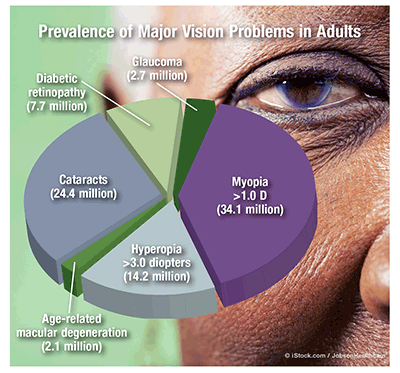US Pharm. 2015;40(6):35.
More than 3.4 million (3%) Americans aged 40 years and older are legally blind or visually impaired. This number is predicted to double by 2030, owing to the increasing incidence of diabetes and other chronic diseases in the aging population. According to the National Eye Institute (NEI), the leading causes of blindness and low vision in 142 million adults older than 40 years in 2010 were cataracts (17%; 24.4 million), diabetic retinopathy (5.4%; 7.7 million), glaucoma (1.9%; 2.7 million), and age-related macular degeneration (ARMD) (1.5%; 2.1 million).

ARMD: In 2010, most ARMD cases occurred among white patients (89%), compared with black and Hispanic patients (both, 4%). Women were disproportionately affected by ARMD (65%), partly because of their greater longevity compared with men. The NEI estimates that the number of people with ARMD will rise by 77% from 2010 to 2030 (3.66 million) and will continue to spiral upward another 49% between 2030 and 2050 (5.44 million). Even though in 2030 and 2050 white patients will still have the highest ARMD prevalence rates, six- and threefold increases are projected to occur among Hispanic and black patients, respectively, owing in part to a shift in demographics. However, the 2010–2030 rate of change in prevalence will be greater than that for 2030–2050 across all racial and ethnic groups.
Diabetic Retinopathy: The number of people with diabetic retinopathy is expected to triple between 2005 and 2050 (from 5.5 million to 14.6 million people), reflecting overall changes in the population and improved diabetes treatment and survival. Diabetic retinopathy is the leading cause of blindness in adults aged 20 to 74 years. In 2010, 7.7 million Americans had diabetic retinopathy; 68%, 16%, and 11%, respectively, were white, Hispanic, and black. The NEI projects that, by 2030, the prevalence of diabetic retinopathy will decrease by 18% among whites and 2% among blacks, but increase by 67% among Hispanics. In 2030 and 2050, the prevalence will remain highest among whites (43.8%), followed by Hispanics (36%). Healthy People 2020 aims to reduce visual impairment due to diabetic retinopathy by 12%.
Cataracts: The prevalence of cataracts has increased by 23% between 2000 and 2010, and the NEI projects that this trend will continue. The increase is expected to be greater from 2010 to 2030 (58%) than from 2030 to 2050 (47%). Because of varying rates of change across race/ethnicity, Hispanics and blacks are each expected to have a prevalence rate of 20% in 2050, and prevalence in whites will drop to 48% (although they will still top the list).
To comment on this article, contact rdavidson@uspharmacist.com.






